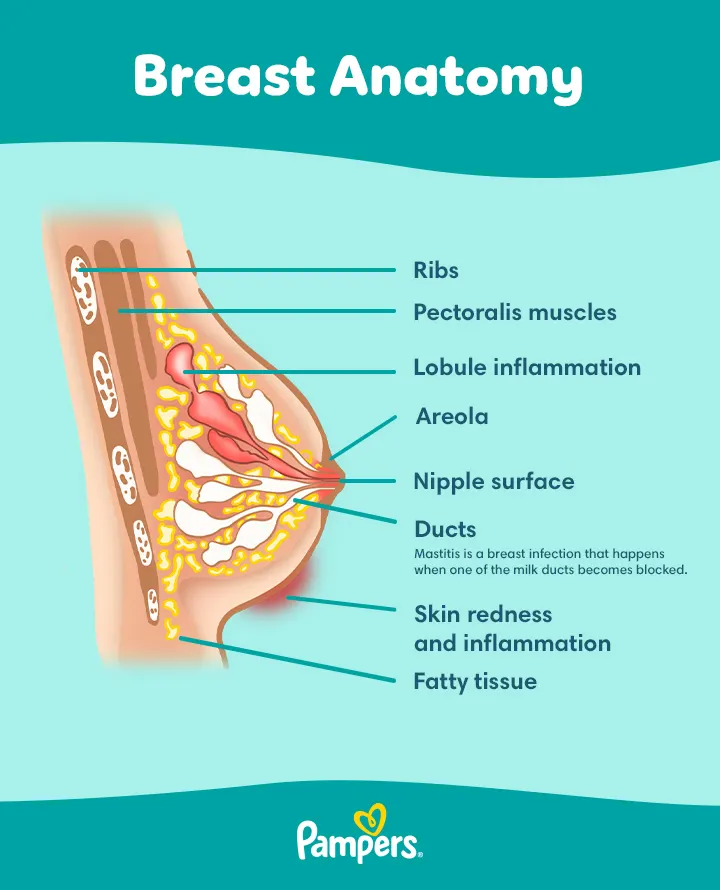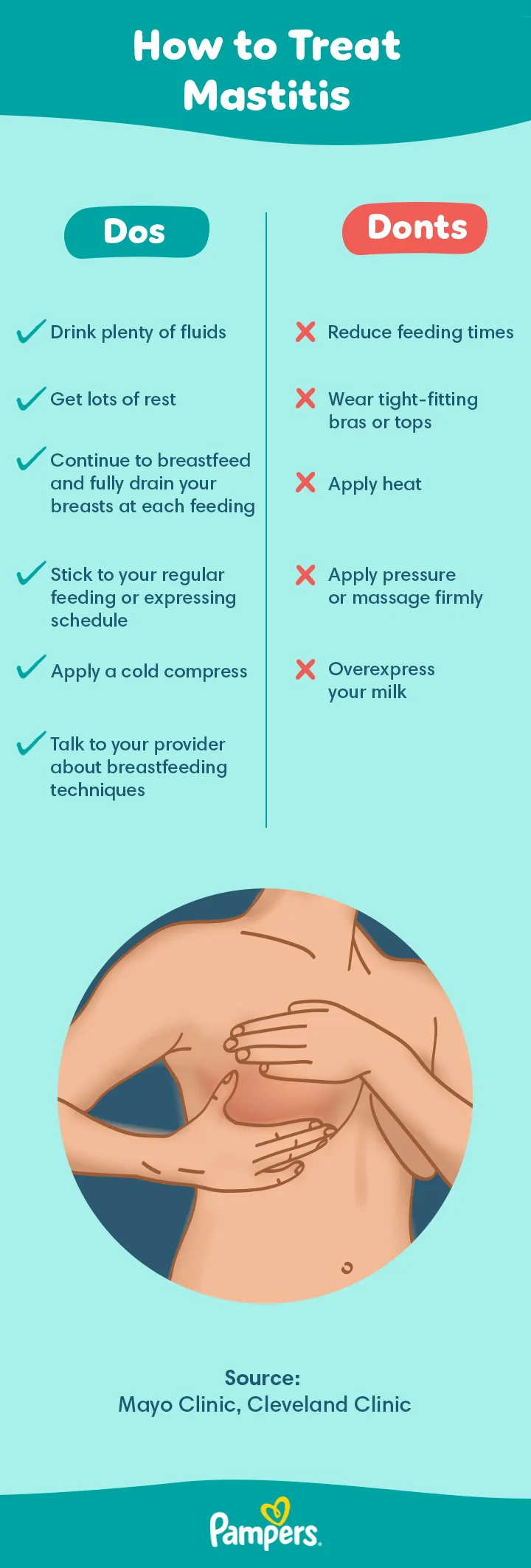Your Guide to Mastitis Symptoms and Treatment
Mastitis can be a challenging experience, especially if you’re a new parent navigating the world of breastfeeding. So, what is mastitis, and how can you manage it effectively? This article will help you understand mastitis symptoms, from the early signs of mastitis to the later stages, and offer insights into treatment options. Whether you’re looking for ways to start curing mastitis or seeking advice on how to handle mastitis while breastfeeding, keep reading for more.
What Is Mastitis?
By definition, mastitis occurs when a buildup of milk blocks a milk duct, causing inflammation of breast tissue. A hard lump can form, and the breast becomes tender and sore. In the case of lactating parents—those who are breastfeeding or pumping breast milk—this condition is called lactation mastitis.
What Does Mastitis Look Like?
Mastitis typically presents as red, swollen, and painful breasts. In some cases, there may be visible red streaks on the skin and a hard, tender lump.
What Does Mastitis Feel Like?
The affected area may feel warm and swollen to the touch. You may also notice a hard, tender lump on one breast.
Breast Abscess Vs. Mastitis
A breast abscess and mastitis can share similar symptoms but are distinct. Mastitis is an inflammation of the breast tissue, often caused by infection, breastfeeding issues, or clogged milk ducts.
A breast abscess, on the other hand, is a localized collection of pus within the breast tissue, usually resulting from an untreated or severe case of mastitis. Abscesses often require drainage and antibiotic treatment to resolve.
Mastitis Symptoms
You may wonder “How do I know if I have mastitis?” and what it feels like compared to the normal tenderness you might feel when you first start breastfeeding. We’ve discussed some of the symptoms in the section above, but here are all the signs and symptoms of mastitis you might experience:
flu-like symptoms such as fever, fatigue, and aches
a hard, tender lump in one breast
red patches on the breast
swelling of the breast
the breast feeling warm to the touch
a burning sensation while breastfeeding.
Causes of Mastitis
If you’re wondering, “How do you get mastitis?” These are some of the causes of mastitis or the risk factors that might increase your chance of developing a mastitis infection:
Clogged milk ducts. This is the most common cause of mastitis. If a milk duct gets clogged with milk, a hard and tender lump will form. This usually occurs when the breasts aren’t fully drained during feedings. If the clogged duct isn’t cleared, an infection may set in.
An oversupply of breastmilk. If you have an oversupply of breastmilk, this may put pressure on your milk ducts, causing them to narrow. This may lead to engorgement which may lead to a mastitis infection.
Incorrect breastfeeding technique. If you don’t vary your breastfeeding positions or don’t fully empty each breast, for example, the milk can build up and become trapped in the milk ducts.
A crack or blister on the nipple. A crack in the skin of the nipple sometimes allows bacteria to enter the milk ducts which may lead to bacterial infection in the breast.
Constraining your breasts. Wearing a bra that is too tight or putting pressure on your breast (for example, from the strap of a heavy bag) can restrict the flow of milk.
A weakened immune system. Being overly stressed or fatigued, or having poor nutrition can suppress your immune system and make you more susceptible to mastitis infection.
Previous bouts of mastitis.
Smoking.
Mastitis Treatment
If you have or have previously had mastitis, you’ll know that the main questions asked are how to get rid of it, and whether there are natural remedies you can use for mastitis. It’s likely your healthcare provider will prescribe medication to clear the infection and reduce discomfort. There are also methods you can use at home to help relieve pain and inflammation. Check out our tips below for more information on how to treat mastitis at home and with medication.
Mastitis Medication
Your healthcare provider will usually prescribe antibiotics for mastitis that are safe for your baby, too. When it comes to curing mastitis, you should begin to notice improvement within a day or two, but it’s important to take the full course of antibiotics, even if the symptoms clear.
Breastfeeding won’t hurt your baby—the milk itself isn't affected—and nursing can actually help clear the mastitis infection. Your healthcare provider might also suggest taking a painkiller to help ease the discomfort. If you have recurring bouts of mastitis, or the infection doesn’t seem to go away, contact your provider again.
Mastitis Self Care
In addition to the treatment your provider recommends, you might try some of these self-care methods and home remedies to help relieve some of the symptoms of mastitis:
Have a consultation with a lactation consultant.
Drink plenty of fluids and get ample rest.
If you’re breastfeeding, fully drain the milk from each breast at each feeding. If nursing is too painful, try hand-expressing or using a breast pump instead.
Don’t reduce feeding times, as this can cause your milk supply to drop, prolonging recovery. Read more about increasing your breast milk supply.
Keep to a regular feeding schedule as much as possible. If something should interrupt this schedule (like your return to work, for example) try to express milk around the same time you’d normally be breastfeeding your baby.
Apply a cold compress to the affected breast to reduce swelling.
Try gentle lymphatic draining which involves light strokes that help move fluid away from the ducts. Avoid firm pressure on your breasts.
Go braless and wear loose-fitting tops.
Try varying your breastfeeding positions to help you and your baby find what works best for you both.
Can You Breastfeed with Mastitis?
If you’re breastfeeding and you have mastitis, you may be wondering if you can still nurse with mastitis. Mastitis does not cause your milk to become infected, and your baby won’t be harmed by nursing. Although breastfeeding with mastitis may be uncomfortable at first, continuing to breastfeed will not only speed up recovery and help keep the mastitis from worsening, but it will also help keep your baby’s immune system stronger because of the antibacterial properties of breast milk.
If you find breastfeeding on the infected breast too painful, one option is to allow the milk to flow out from the affected breast onto an absorbent cloth or towel while you have your baby nurse on the other breast. After relieving some of the pressure, you might be able to finish nursing on the affected breast without too much discomfort. Another option is to pump the breast and then either store the milk or feed it to your baby.
The discomfort of mastitis can be discouraging, but treatment can quickly help clear up the problem, allowing you to continue to enjoy the great benefits of breastfeeding.
How Long Does Mastitis Last?
If treated appropriately, such as taking the prescribed antibiotics, using cold compresses, and getting plenty of rest, the symptoms of mastitis may ease within 24 to 72 hours. It may take about 10 to 14 days for a full recovery from inflammatory mastitis.
So, can mastitis go away on its own? Mastitis generally needs early treatment and home care to prevent the infection from worsening. If you have mastitis, it’s always best to consult your healthcare provider and try the treatment methods mentioned in this article.
How to Avoid or Prevent Mastitis
Here are some ways to help you avoid mastitis:
Switch up your breastfeeding positions to fully empty each breast.
Make sure your baby is properly latched onto your breast.
Feed your baby for as long as they will eat.
Don’t leave too much time between feedings. For example, if you usually feed your baby about every two hours, try to stick to that schedule.
Eventually, when you decide it’s time to stop breastfeeding and wean your baby, you may wonder how to dry up your milk supply without getting mastitis. The key is to wean gradually. Ask your lactation consultant or healthcare provider for guidance.
When Should You Contact Your Healthcare Provider?
Early treatment of mastitis is important. Speak with your healthcare provider or lactation consultant if the early signs of mastitis don’t clear up promptly after trying at-home remedies for a few days, or if your symptoms worsen after 24 hours of antibiotics.
A spike in fever, pus or blood in your milk, and red streaks from your nipple to your underarm are signs that the mastitis infection has worsened. If left untreated, symptoms can worsen and an abscess can form.
FAQS AT A GLANCE
Yes, continuing to breastfeed can help clear the mastitis infection, and your breast milk also helps strengthen your baby’s immune system.
The Bottom Line
Breastfeeding or pumping with mastitis can be difficult and frustrating. Try to be patient and gentle with yourself during this time. With good at-home care under the direction of your healthcare provider, it won't be long until you're able to get back to enjoying this bonding time with your baby.
And if you want rewards and discounts on all those diapers your little one uses, download our Pampers Club app today.
How We Wrote This Article The information in this article is based on expert advice found in trusted medical and government sources, such as the American Academy of Pediatrics and the American College of Obstetricians and Gynecologists. You can find a full list of sources used for this article below. The content on this page should not replace professional medical advice. Always consult medical professionals for full diagnosis and treatment.
Join Pampers Club and get:






